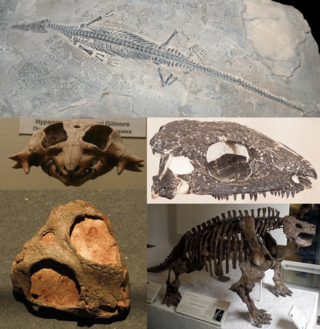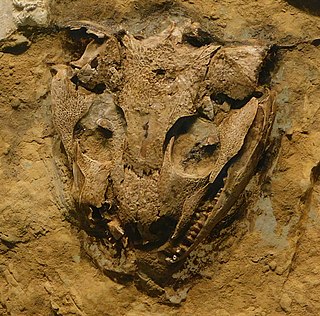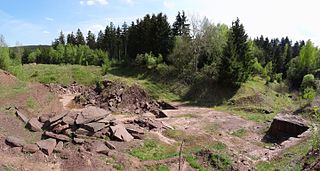
Eureptilia is one of the two major subgroups of the clade Sauropsida, the other one being Parareptilia. Eureptilia includes Diapsida, as well as a number of primitive Permo-Carboniferous forms previously classified under Anapsida, in the old order "Cotylosauria".

Protorothyrididae is an extinct family of small, lizard-like reptiles belonging to Eureptilia. Their skulls did not have fenestrae, like the more derived diapsids. Protorothyridids lived from the Late Carboniferous to Early Permian periods, in what is now North America. Many genera of primitive reptiles were thought to be protorothyridids. Brouffia, Coelostegus, Paleothyris and Hylonomus, for example, were found to be more basal eureptiles in Muller and Reisz (2006), making the family as historically defined paraphyletic, though three genera, Protorothyris, Anthracodromeus, and Cephalerpeton, were recovered as a monophyletic group. Anthracodromeus, Paleothyris, and Protorothyris were recovered as a monophyletic group in Ford and Benson (2020), who recovered them as more derived than captorhinids and Hylonomus, but less so than araeoscelidians. Anthracodromeus is the earliest known reptile to display adaptations to climbing. The majority of phylogenetic studies recover protorothyridids as basal members of Eureptilia; however, Simões et al. (2022) recover them as stem-amniotes instead.

Captorhinidae is an extinct family of tetrapods, typically considered primitive reptiles, known from the late Carboniferous to the Late Permian. They had a cosmopolitan distribution across Pangea.

Seymouria is an extinct genus of seymouriamorph from the Early Permian of North America and Europe. Although they were amphibians, Seymouria were well-adapted to life on land, with many reptilian features—so many, in fact, that Seymouria was first thought to be a primitive reptile. It is primarily known from two species, Seymouria baylorensis and Seymouria sanjuanensis. The type species, S. baylorensis, is more robust and specialized, though its fossils have only been found in Texas. On the other hand, Seymouria sanjuanensis is more abundant and widespread. This smaller species is known from multiple well-preserved fossils, including a block of six skeletons found in the Cutler Formation of New Mexico, and a pair of fully grown skeletons from the Tambach Formation of Germany, which were fossilized lying next to each other.

Sphenacodontoidea is a node-based clade that is defined to include the most recent common ancestor of Sphenacodontidae and Therapsida and its descendants. Sphenacodontoids are characterised by a number of synapomorphies concerning proportions of the bones of the skull and the teeth.

Parareptilia ("near-reptiles") is a subclass or clade of basal sauropsids/reptiles, typically considered the sister taxon to Eureptilia. Parareptiles first arose near the end of the Carboniferous period and achieved their highest diversity during the Permian period. Several ecological innovations were first accomplished by parareptiles among reptiles. These include the first reptiles to return to marine ecosystems (mesosaurs), the first bipedal reptiles, the first reptiles with advanced hearing systems, and the first large herbivorous reptiles. The only parareptiles to survive into the Triassic period were the procolophonoids, a group of small generalists, omnivores, and herbivores. The largest family of procolophonoids, the procolophonids, rediversified in the Triassic, but subsequently declined and became extinct by the end of the period.

Eudibamus is an extinct genus of biped bolosaurid ankyramorph parareptile known from the Free State of Thuringia of central Germany. It had a very small size reaching only 25-26 cm in length.

Bolosaurus is an extinct genus of bolosaurid ankyramorph parareptile from the Cisuralian epoch of North Asia and North America.

Captorhinus is an extinct genus of captorhinid reptiles that lived during the Permian period. Its remains are known from North America and possibly South America.

Labidosaurikos is a genus of extinct captorhinid anapsid reptile that lived around 279 to 272 million years ago during Kungurian age of the lower Permian. The American paleontologist John Willis Stovall first described Labidosaurikos in 1950, naming it "Labidosaurus like" for the striking similarity of the holotype skull of his specimen to the cranial anatomy of another captorhinid Labidosaurus hamatus. Labidosaurus or generally called "lipped lizard" is another genus of the family Captorhinidae whose name is derived from the Greek for "forceps lizard" based on τσιμπίδα and σαυρος ("lizard")

Anconastes is an extinct genus of dissorophoid temnospondyl within the family Trematopidae. It is known from two specimens from the Late Carboniferous Cutler Formation of north-central New Mexico in the southwestern United States. The genus name derives from two Greek roots, ankos and nastes ("inhabitant"), which refers to the type locality of El Cobre Canyon where the specimens were found. The specific name is derived from the Latin word vesperus ("western"). The more complete specimen, the holotype, is a partial skull with articulated mandibles and a substantial amount of the postcranial skeleton. The less complete specimen, the paratype, consists only of the right margin of the skull with an articulated mandible.
Actiobates is an extinct genus of trematopid temnospondyl that lived during the Late Carboniferous. It is known from the Garnett Quarry in Kansas.

Tambachia is an extinct genus of dissorophoid temnospondyl within the family Trematopidae. It is known from the Early Permian Tambach Formation near the town of Tambach-Dietharz in Thuringia, Germany. Tambachia is the first trematopid to have been discovered outside the United States.

Georgenthalia is an extinct genus of dissorophoid temnospondyl from the Lower Permian. It is an amphibamid which lived in what is now the Thuringian Forest of central Germany. It is known from the holotype MNG 11135, a small, complete skull. It was found in the Bromacker locality of the Tambach Formation. It was first named by Jason S. Anderson, Amy C. Henrici, Stuart S. Sumida, Thomas Martens and David S. Berman in 2008 and the type species is Georgenthalia clavinasica.
Tambaroter is an extinct genus of ostodolepid microsaur from the Early Permian of Germany. The type species T. carrolli was named in 2011. Tambaroter is known from a single skull found in the Tambach Formation, which is the lowermost unit of the Upper Rotliegend. It is the only vertebrate that has been found outside the Bromacker Quarry, the most productive locality of the formation. It is also the first ostodolepid known from outside North America.

Euconcordia is an extinct genus of Late Carboniferous captorhinid known from Greenwood County, Kansas of the United States.
Rhiodenticulatus is an extinct genus of Early Permian captorhinid known from Rio Arriba County, New Mexico of the United States.

Rotaryus is an extinct genus of Early Permian trematopid dissorophoid temnospondyl known from the Free State of Thuringia of central Germany.

The Tambach Formation is an Early Permian-age geologic formation in central Germany. It consists of red to brown-colored sedimentary rocks such as conglomerate, sandstone, and mudstone, and is the oldest portion of the Upper Rotliegend within the Thuringian Forest Basin.
Tambacarnifex is an extinct genus of varanodontine synapsids known from the Early Permian Tambach Formation of Free State of Thuringia, central Germany. It was first named by David S. Berman, Amy C. Henrici, Stuart S. Sumida, Thomas Martens and Valerie Pelletier in 2013 and the type species is Tambacarnifex unguifalcatus.




















